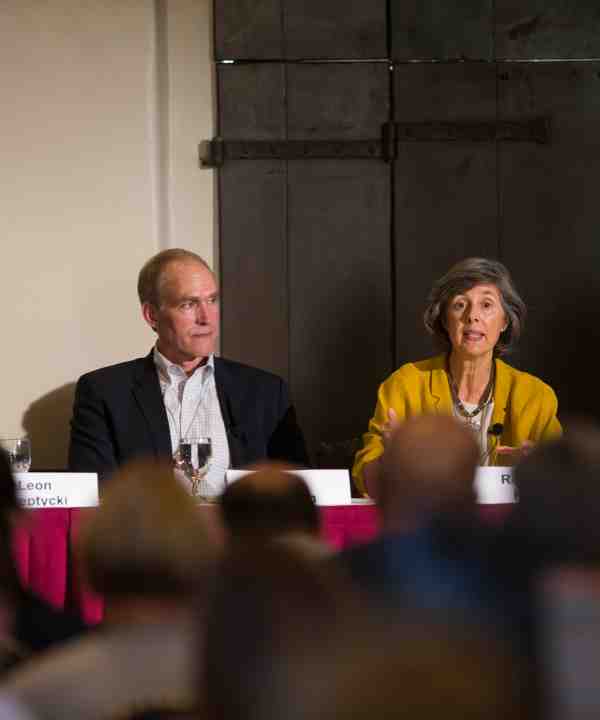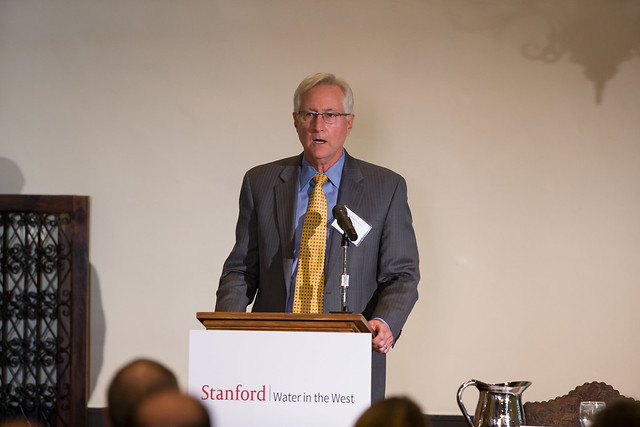October 14, 2016 | Bill Lane Center for the American West | News
Of all the hurdles facing the California water stewards as they try to create a system for managing groundwater sustainably, two stand out. One, knowing where groundwater basins are, how much is in them, and how fast they are being depleted – or recharged. Two, setting up the institutions to do the job.
In a Sacramento forum sponsored by Water in the West on Sept. 27, Stanford researchers presented snapshots of their research into groundwater measurement and offered suggestions about how data can be improved. The session was kicked off by Mark Cowin, the director of California’s Department of Water Resources, who argued that the greatest need is to create trusted, interlocking institutions to manage the process.
Cowin said that “technical information is not our highest need.” An even more important challenge, he said, is human and organizational. “Simply put, how do we foster the creation of durable, resilient local institutions that can enforce groundwater pumping and recharge at sustainable levels?” (Watch video of his remarks).
Cowin offered the remarks as part of the keynote speech at the groundwater briefing Sept. 27, which was moderated by Leon Szeptycki, the executive director of the Water in the West program. The program is cosponsored by the Stanford Woods Institute for the Environment and the Bill Lane Center for the American West.
Other panelists included Rosemary Knight, the George L. Harrington Professor in the School of Earth, Energy and Environmental Sciences, who has been doing remote mapping of groundwater formations using satellite data. She joined fellow Stanford Earth professor Rob Jackson, the Michelle and Kevin Douglas Provostial Professor, who earlier this year reported a find of a previously unrecognized large but very deep store of California groundwater. Tara Moran, program lead for Water in the West’s Sustainable Groundwater Program, completed the panel with a presentation about improving groundwater data.
After decades operating a system which allowed individual property owners to make their own decisions about groundwater pumping, and given that such pumping was — and often still is — seen as an individual right, setting up collaborative mechanisms for control will be difficult, Cowin said.
Referring to the state legislature’s 2014 passage of the Sustainable Groundwater Management Act, Cowin said “It took 100 years” after establishment of surface water controls “before lawmakers were willing to regulate groundwater.”
He added, “It’s going to take time for Californians to shift from a mentality of pump “whatever you want” to pumping in accord with a sustainable budget.
To foster trust in the new institutions means assembling them carefully, the experts and expertise needed will require investment. “The highest need now is not technical but human and organizational,” he said, adding that the state has been investing bond money and working with a group of organizational facilitators.
But both the complexity of the law, the novelty of pumping restrictions and water users’ fear of change and potential water loss make it difficult to created efficient and trusted institutions.
Water in the West Researchers Present Findings
The need for data, and new possibilities of how to gather accurate information on groundwater’s locations and amounts was the focus of Knight’s presentation. Her work focuses on getting better technical data for mapping and accounting for groundwater extraction and groundwater recharge.
By embedding electrodes in the sand along the coast near Monterey, she said, scientists are able to use imaging created by electrical resistivity “to determine what’s down there,” and see up to 1,000 feet beneath the surface. This allows mapping of the exact locations of saltwater intrusion into the freshwater in coastal aquifers. Such intrusion has for decades been one of the most damaging consequences of excessive groundwater withdrawal near the coast.
The imaging Knight presented reflected the success that the Pajaro Valley Water Management Agency had in recovering areas that had suffered from saltwater intrusion.
She also described an airborne mapping process that also uses electromagnetism —- through a large panel swinging underneath a helicopter — which can produce images up to 1,600 feet below the surface.
The data from both processes, she said, allows water managers to “come together and understand the complexity of the problem they need to address.” The goal of such measurements, she added, “is getting at the big picture. Where are the basin boundaries? Where are the sub basin boundaries?”
Jackson is relatively new to California water issues but has spent years studying the data required to extract energy resources from the ground and data about the subsurface data that can be learned in the process of extraction. “I’m a data guy,” he said. “I made one suggestion about mandating public water data every time a municipality drills a public water well or every time we drill an energy well.”
He added “the importance of making data available and being able to use that down the road can’t be overstated,” he said. He urges the continual collection of more data, and “making those data available in a form people can use or analyze.” (Watch video of the presentation)
Tara Moran focused on the question of getting adequate, and mutually compatible, groundwater data across the state, and her efforts to poll water agency representatives about what they need. (Video) She described a groundwater data workshop at Sacramento State University which is doing work on the problem. She said that, while local agencies collect substantial amounts of data, their findings don’t always fit the information needs of decision makers.
“The ability to have a standard data protocol in a huge thing,” she said.
Later, Moran added, “It’s going to be important for basins to take stock of where they are at and what is required.” Many local agencies collect a lot of data but it is often inadequate for making decisions, she said. A paramount and very challenging goal, she said, is making sure “the foundational data sets being collected are of high quality and useful moving forward.”
Watch Video from the event:



![[Woods Logo]](/sites/default/files/logos/footer-logo-woods.png)
![[Bill Lane Center Logo]](/sites/default/files/logos/footer-logo-billlane.png)